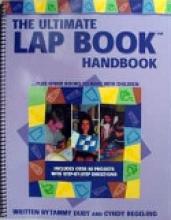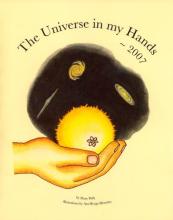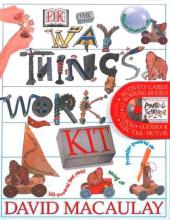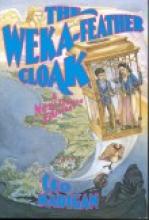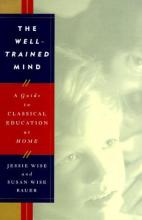No name
The Ultimate Lap Book Handbook...Plus Other Books to Make with Children
When it comes to craft projects, I am all thumbs. If I must struggle with following incomprehensible directions and managing difficult techniques, I prefer to end up with something delicious to eat. You can imagine my fear when I was first introduced to lap books–-described by the author of the Ultimate Lap Book Handbook as "a file folder folded a funny way, and then filled with child-produced booklets". As I read through this book, my fear turned to fascination. This was one incredible project that even I could handle!
The authors begin with a very convincing ten-reason list of paragraphs describing why and how the making of books is beneficial to a student of any age. They continue with a section on Lap Books, including the basic ways of folding the folder and the booklets that go inside. Construction, assembly, and layout techniques are also discussed, and cover designs and FAQs are described. The next section is titled "Beyond Lap Books" and contains the instructions for making simple books, stick books, pizza books, hardcover books, and more. Are you getting overwhelmed yet? Don't! This is where most "how-to" books end, expecting you to be able to apply these ideas to your own homeschool. The Ultimate Lap Book Handbook is just getting to the best part.
The heart of the book is the Book Blueprints section. The authors proceed through Bible, History, Literature. Math (Yes! Even Math!), Science, and Social Studies, and they offer step-by-step directions for more than fifty projects at all grade levels. Will your 3rd-8th grade student be studying the Ten Commandments? Does your high schooler need a Math Formula Flip Book? Would your K-4th grader enjoy making a Weather book? The well-illustrated project directions provide no-fail projects for the craft-challenged as well as a comprehensive range of starter ideas for experienced "Fun Moms". Many black-and-white photographs of finished projects are also included. Each project description includes Writing Prep and Presentation sections in addition to any helpful tips. More advanced projects also include a list of materials, suggested booklets for the inside, assembly directions, and evaluation guidelines. These techniques can be used with any homeschooling method from strictly classical to unit study to textbooks. They can be used with just one child or a CCD class or a Scout group. I can't wait to get started making our next book!
The Universe in My Hands
The author, Mary Daly, explains her book and purposes in this overview.
I have long had a concern about the teaching of science. Most of the materials on the market are so scattered that I cannot think that children will have a clear concept of the meaning and value of science, nor any feeling that they can master its contents in any way. Indeed, most texts are centered on defining science as the product of a specific "method" of thought which has to do with hypotheses and experiments and records and reports. Boring ...and not at all the way Einstein or anybody else I know of actually operated.
Anyway, Natural Science was born in response to the command in Genesis: "Increase and multiply and fill the earth and subdue it." We cannot subdue – or exert stewardship – over what we do not understand. Science is about understanding the material world, our very exciting and beautiful home. In the spring of 2000, members of the local homeschool support group met for a week's science camp, and the next two years, followed up with weekly (almost weekly) science lessons.
The principle of organization is to understand the magnitudes – the sizes – of things and how their scale limits what they can be and do. A star, for example, cannot be much smaller than our sun – except by being fantastically dense – because the nature of stars requires that their gravity bring about their burning. A fly doesn't have enough gravity to burn that way. The planet Jupiter has almost enough.
With the curriculum organized around magnitudes, we had a principle of order for the relationships between all the disciplines of natural science, and as our body of knowledge increased, it was always interactive with previous information. Furthermore, there are only 45 magnitudes between the quark and the universe; this is a small enough number for any child to comprehend. He can finish the course feeling that he knows the universe – and why not? It is his home.
The science camp material is now available, suitable for a camp, or a semester, or up to a year for a small child. It includes:
1. A booklet about the 45 orders of magnitude – sorted by powers of ten – which form the universe as far as we know it. The booklet goes very slowly through the nine orders readily recognizable to ordinary sight – from a meter down to a tenth of a millimeter, and then up to ten kilometers. (It is really essential to use metric measure for this exercise. It is not assumed that the student already knows it.)
2. A set of 45 cardstock dividers, numbered and color-coded, one for each order of magnitude. These are to be placed in a notebook and materials collected illustrating objects at each magnitude are to be placed in each section by the student. These materials can be pasted pictures, drawings, reports, web printouts – whatever best represents what the student has considered at that order of magnitude, and according to his level of comprehension.
The color-coding of the dividers has to do with the fact that the smallest things we consider – electrons and protons, are studied in physics. The next smallest – molecules – are the study of chemistry. Then biology, with green dividers, and so forth.
I will be working to get the following year's lessons into print. They strengthen the magnitudes theme by taking various objects and explaining their characteristics, always in relationship to the orders of magnitude that shape them. Of course the lessons were printed at the time for my students, but not always in a well-finished form...
Copyrights 2002/2006
Consists of a booklet and a set of 45 cardstock dividers for a 3 ring binder.
The Universe: Think Big!
Jeanne Bendick, author of Archimedes and the Door of Science, explains some basic concepts regarding the universe in a surprisingly simple way (approximately 2nd grade reading level - short pages with large type). First she invites children to try to imagine how big the universe is (in terms of it being much, much bigger than other, more familiar things). The bulk of the book focuses on large distances and how they're measured and how people used to believe that the earth was at the center of the universe and remained motionless. The final page explains the big bang theory. For a controversial topic it is explained rather nice in terms of "How did the Universe begin? Nobody knows for sure, but here is what most scientists of today think." Although the big bang theory was first thought of by a Catholic priest (LeMaitre) who was trying to point toward something which God created, we all know that the big bang theory is often used to try to explain God away. Young children don't have much trouble with this when presented as it is in this book. After the book says "Suddenly, this object exploded with a big bang," you can ask your children, "If this is the way the Universe really did begin, then who made the explosion happen?" Chances are, they'll know the answer. :)
The Victory Garden Alphabet Book
I found this in our library's seasonal display... copyright 1992, certainly not a new title, but my love for alphabet books and vegetables together made me decide to take a look.
Product description: Bestselling author Jerry Pallotta teams up with former Victory Garden host Bob Thomson to present 26 common and not-so-common vegetables. Learn about fiddleheads, munchkin pumpkins, sweet peas, walla wallas, and more. This informative book also includes a brief introduction to soil preparation and seed planting. 30 color illustrations.
These times of economic slump and contaminated foods from doubtful origins is seeing a huge growth in home gardening. I have seen this new trend being referred to as "Victory Gardens" all over again. This is a nice and informative book for children, most especially children whose parents want to encourage to get out there and help! The illustrations are very realistic and seem to be based on photos.
The Virtue Driven Life
The Way Things Work Kit
This kit provides dozens of special cardboard pieces, wooden dowels string, wheels, etc. for making simple machines (inclined planes, scales, etc.) that can be used for understanding basic concepts of mechanics – how things work. Based upon the bestselling "The Way Things Work" by David Macaulay, the kit continues the theme of Wooly Mammoths as props and characters for use in these experiments. (Included in the kit are two cardboard Wooly Mammoths to which you affix a certain number of identical coins to provide a common weight for some of the experiments.) A thin, but colorful book (32 pages – glossy cover) takes you through the scientific explanations of the various principles involved in the experiments. 5 1/2 " x 8 1/2" glossy full color cards provide detailed step-by-step instructions (with the typical DK photos) for each experiment.
Although some of the experiments took a little more finesse than might have been expected (but understandable due to the limitations of the materials) and some of the instruction cards were a little hard to follow, overall we found this to be an exceptional value – a lot of bang for your buck at the $30 retail price. We found that a dozen or so ziploc bags were very helpful in keeping the various pieces straight and, with a little patience, all the pieces can be stored in the box.
The biggest hit in our family so far was the Pinball Science CD ROM which also came with the kit.  The game includes three pinball arenas each having a specific theme (village, island and moon). The science part involves answering questions in order to earn the right to place certain fixtures on each pinball game. Without the fixtures, scores are lower and players are unable to advance to the next level. With each question, the player has the option to "Research Answer". This feature takes the player to the appropriate page in an interesting, humorous and interactive log book which explains the functioning of various devices such as windmills, faucets, hot-air balloons, gears, and rockets. Some of the graphics are a little silly (Wooly Mammoths in bikinis on the island and such), but I didn't find anything really objectionable.
The game includes three pinball arenas each having a specific theme (village, island and moon). The science part involves answering questions in order to earn the right to place certain fixtures on each pinball game. Without the fixtures, scores are lower and players are unable to advance to the next level. With each question, the player has the option to "Research Answer". This feature takes the player to the appropriate page in an interesting, humorous and interactive log book which explains the functioning of various devices such as windmills, faucets, hot-air balloons, gears, and rockets. Some of the graphics are a little silly (Wooly Mammoths in bikinis on the island and such), but I didn't find anything really objectionable.
The Weight of a Mass
The best and most memorable lessons are taught through stories, and this gorgeous picture book will teach an unforgettable one. The Weight of a Mass is written in a fairy-tale style and enhanced by rich watercolor illustrations. It will appeal equally well to both boys and girls through countless re-readings.
Said to be based on a true event, the story unfolds as a poor, elderly woman begs for a crust of bread in a bakery. The baker scoffs at her request and demands to know what she will pay. Penniless, the woman offers to hear Mass for the giver of the bread in exchange. To prove that her offer is worthless, the baker writes "One Mass" on a slip of paper and places it on one side of a balance. As more and more delicacies are added to try to balance the scale, the slip of paper demonstrates miraculously that there is nothing on earth of greater value than the Mass.
This book is the perfect gift for a First Communicant, an adult who needs a gentle reminder of the value of their Faith, or anyone who enjoys reading to a child. Our children each have a "treasure chest" of things that they will take with them when they are grown and begin their own homes and families. I am purchasing a copy of this book for each of my children to place in their treasure chests. It deserves all of the awards that it has earned!
The Weka-Feather Cloak
Now for a little of the plot.... Danny Mago is a small, quiet 16 year old who is mercilessly picked on by his schoolmates, but recognized by his teachers as having remarkable artistic abilities. Knowing that his widowed mother is struggling to financially support Danny and his handicapped sister Angela, the deputy headmistress of his school offers him a job helping out on the grounds of the nun's convent and working as artistic assistant to Mother Madeleine, a renowned local artist. In cleaning up and cutting back overgrown portions of the convent grounds, Danny discovers an ancient elevator through which he visits some interesting historical characters. Soon he becomes involved in a contest to plan a backdrop to the altar of the new cathedral and a strange Turkish girl searching for an ancient painting of Our Lord (the Mandylion - rhymes with pavilion, not dandylion). Throw in an ancient Maori cloak and some mysterious trips courtesy of his guardian angel, and the result is a rather enjoyable, occasionally hair-raising, adventure story in a Catholic framework with a New Zealand setting. (There are interesting artistic sub-themes as well.) The author has included a glossary of New Zealand terms and an overview of some of the religious references. My two year old highly enjoys just hearing the words in the glossary which sound very funny to her - aniwaniwa, kohekohe, tiki, etc.
The author has a humorous writing style that should be appealing to modern readers. Leo Madigan, who has also authored a number of books about Fatima, skillfully interweaves a Catholic way of looking at things, but never at the expense of a good story. I especially like the sub-plot concerning Danny's sister Angela, who is seriously disabled. Her relationship with Danny is beautifully portrayed (they communicate with each other using their own system of sign-language, he confides in her during difficult times). Also, unlike a number of stories with crippled heroes who are cured in the end (like If All the Swords in England and The Hidden Treasure of Glaston), Angela's part of the story wraps up happily even though she is not completely cured of her malady. I appreciate this unique angle, especially for those who are dealing with such difficulties every day for the rest of their lives. There wouldn't be much hope for these much-beloved souls if happiness depended on a miraculous physical cure.
I hope you and your children (best for ages 12 and up) enjoy the story as much as I did.
This title was donated for review by Bethlehem Books
The Well-Trained Mind
Jessie Wise started homeschooling her daughter (and co-author Susan Wise Bauer) in 1973. In this book they elaborate ideas and resources for a complete classical curriculum from preschool through high school. From a Catholic standpoint, I think this book would be most useful for those who are already using Designing Your Own Classical Curriculum, but looking for additional ideas. I found the explanations of the stages of the Trivium very helpful as well as some of the ideas for types of writing assignments, lists of subject material and tidbits on scheduling and record-keeping. I also found the order in which certain materials are to be studied (particularly for History which they recommend studying in chronological fashion starting in first grade) to be more to my liking than the order proposed in Designing Your Own Classical Curriculum because I'd like to have my children studying the same topic in History at the same time. The authors had some important things to say about the problems with television and I really enjoyed (as a bit of a vindication of my own educational ideas I suppose) the story about Dr. Seuss and why he wrote The Cat in the Hat.
I would be reluctant to give this book to a mother who is already feeling overwhelmed with homeschooling or one who has just pulled her children out of a conventional school and is beginning to homeschool later in the game. Although it is not intended to be, I think it might be intimidating at this stage. Although the authors (who are not Catholic) don't fall into a number of "traps" regarding the Catholic Church that one might expect (as is clear from their segment on Religion), some of the resources (especially with regards to History) contain biases against the Catholic Church and should be used only with caution. A great deal of their recommended materials are those recommended by Greenleaf Press and/or published by Dorling Kindersley - I use materials from both of these sources, but many should be approached with caution if not avoided altogether.
I have not read the book in its entirety yet (I finished the Grammar segment and skimmed the rest). Overall, I found it worthwhile reading, but not "required reading", and some things should be taken with a grain of salt.
You can find out more about the book at the Well Trained Mind website run by co-author Susan Wise Bauer.

